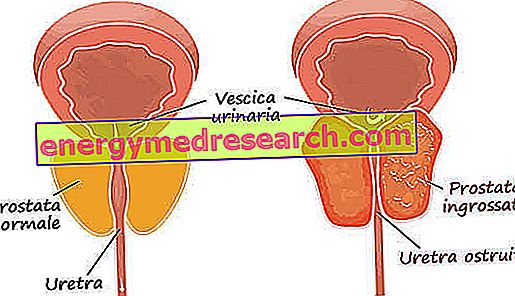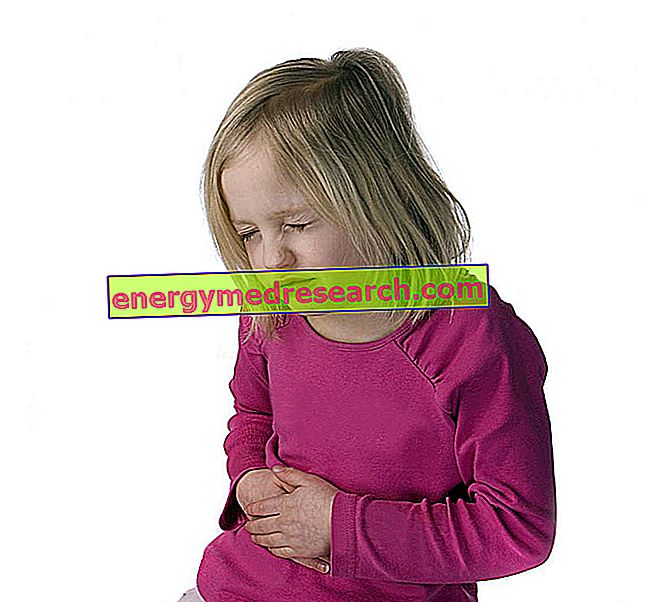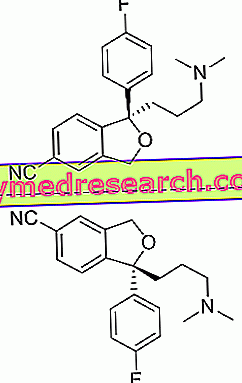Generality
Volvulus is the phenomenon of abnormal torsion of an intestinal tract on itself and with respect to the portion of mesentery that supports this tract.
More frequent in infants and very young children, the volvulus can degenerate into two dangerous complications: in the intestinal block (or intestinal obstruction) and in a reduction of the blood supply to the tract of bowel subject to torsion.

Volvulus causes various symptoms, including abdominal pain, abdominal cramps, vomiting, nausea, abdominal bloating and flatulence.
To prevent the volvulus from having serious consequences, sometimes lethal for the patient, timely diagnosis and treatment are essential.
What is the volvulus?
Volvolo is the medical term that describes the anomalous torsion of a loop of intestine on itself and with respect to the portion of mesentery that supports this loop.
More frequent in infants and very young children, episodes of volvulus can be fatal due to the effect of two important consequences.
The first important consequence is the so-called intestinal blockage . Also known as intestinal obstruction, the intestinal block is that serious medical condition characterized by the presence of a partial or complete obstruction in a point of the intestine, such as to slow down (if it is partial) or block (if it is complete) the transit of the products of digestion; when the obstruction is severe and the treatments are not timely, intestinal blockage can be fatal for the patient.
The second important consequence is the reduced blood supply to the affected intestine ( intestinal ischemia ). For the organs of the human body - including the intestine - a reduced supply of blood is the cause of damage and suffering, as it involves less oxygenation of the individual cells. If the lower blood supply to the intestine cells is prolonged, the cell damage progressively leads to cell death by necrosis .
Epidemiology
Volvulus is an uncommon phenomenon in general. According to some estimates, the geographical areas of the world where it is most frequent would be Africa, the Middle East and India.
In a country like the United States, the volvulus phenomenon has a rather low annual incidence, equal to about 2-3 cases per 100, 000 inhabitants.
Volvulus can affect people of all ages; however, as mentioned, according to statistical estimates it is more widespread in the youth population.
The non-intestinal volvulus
A twist similar to the one that distinguishes the volvulus against the intestine can also relate to another organ of the digestive system: the stomach .
The phenomenon of twisting of the stomach on itself is called gastric volvulus ; the adjective "gastric", in these circumstances, is fundamental to distinguish it from the simple word "volvulus", which traditionally refers to a problematic of the intestine.
Causes
The main cause of volvulus is a congenital defect of the intestine, called intestinal malrotation .
The intestinal malrotation is, substantially, the condition resulting from the incorrect rolling up, during fetal development, of what will be the future intestine. In other words, intestinal malrotation is the result of the wrong disposition of what, in the fetus, represents the intestine of the human being at birth.
Generally, the development of the volvulus, due to an intestinal malrotation, occurs during the first few months of life.
Minor causes of volvulus
Among the less common causes of volvulus, include:
- Hirschsprung's disease . It is a congenital anomaly characterized by the absence of nerve endings that control the smooth muscle of the colon, necessary for the correct development of intestinal peristalsis.
Hirschsprung's disease is one of the main causes of intestinal blockage in newborns;
- The meconium ileum . It is a condition of the newborn that consists in intestinal obstruction due to the presence of very compact and viscous meconium. It is typical of individuals born with cystic fibrosis;
- Abdominal adhesions of the intestine, severe and prolonged constipation ; diseases of the nervous system such as Parkinson's disease ; diabetes . They have in common the fact that they are causes of volvulus in the adult individual.
Volvulus risk factors
Volvulus risk factors include:
- The presence of congenital defects in the intestine, such as intestinal malrotation (one of the main medical conditions associated with the development of a volvulus);
- The presence of dolicocolon, ie a colon much longer than normal;
- Hirschsprung's disease;
- The pregnancy;
- Abdominal adhesions with intestinal site;
- Prolonged constipation;
- A diet high in dietary fiber.
Types of volvulus
Assuming as a distinctive parameter the site of the torsion of the intestinal loop, doctors distinguish the volvulus into:
- Blind volvulus . The twist concerns the first part of the large intestine, also called the blind;
- Sigmoid volvulus . Torsion is located on the tract of the large intestine known as sigma (or colon sigma);
Sigmoid volvulus is the most common type of volvulus.
- Volvulus of the transverse colon ;
- Ileo-sigmoid volvulus . It is a very particular type of volvulus, in which a tract of ileus forms a knot around the sigmoid colon;
- Volvulus of the splenic fissure . The twist relates to the curvature of the colon that separates the transverse colon and the descending colon.
The volvulus of the splenic fissure is the rarest typology of volvulus.
Symptoms, signs and complications
The precise symptomatology of a volvulus depends on where the latter is located, along the intestine. Thus, every type of volvulus causes symptoms and characteristic signs.
A summary list of all the possible manifestations that may arise from a volvo includes:
- Abdominal pain;
- Abdominal cramps;
- Abdominal distention (or abdominal swelling);
- Increased abdominal tension;
- Vomiting and nausea;
- Biliary vomiting;
- Flatulence;
- Constipation;
- Increased heart rate and respiratory rate;
- I did it with blood.
Symptomatic picture of the cecal volvulus and the sigmoid volvulus
The cecal volvulus and the sigmoid volvulus are among the two most common types of volvulus, so it is worth dwelling on them to describe the symptomatology.
In the blind volvulus, the predominant symptoms are: nausea, vomiting and flatulence.
In the sigmoid volvulus, however, the predominant disorders are abdominal pain and constipation.
How do babies experience abdominal pain?
Infants and very young children cannot communicate painful abdominal pain, as an adult would. However, they also manage to make themselves understood in two very clear ways: crying crying and curling the legs towards the chest (this movement is, for them, a relief from pain).
What does the presence of symptoms depend on?
During episodes of volvulus, the presence of symptoms is due to two mechanisms already known to readers:
- Intestinal blockage (or bowel obstruction)
- The reduction of blood supply to the intestine tract is the cause of torsion (ischemia).
Congenital conditions associated with volvulus
According to some statistical studies, 70% of newborns suffering from volvulus have congenital defects, including: congenital diaphragmatic hernia, gastroschisis, infalocele, anorectal malformations, cardiac malformations, liver malformations and spleen malformations.
Complications
The complications of a volvulus are the same as for intestinal blockage (intestinal perforation, blood loss and infections) and intestinal ischemia (death of the section of intestine that no longer receives appropriate oxygen levels).
When should I go to the doctor?
In light of the possible complications of a volvulus, the latter represents a medical urgency, to which immediate relief must be given from the first symptoms.
Diagnosis
Generally, the diagnosis of volvulus requires:
- A thorough physical examination and a careful medical history .
They usually represent the first step of the diagnostic path. Allow the doctor to know and evaluate the symptoms, and get an idea of what the causes could be;
- X-ray of the abdomen . It serves to deepen what emerged from the physical examination and from the anamnesis. Normally, if there is a volvulus, the radiograph of the abdomen highlights it without particular difficulties;
- Abdominal CT . Provides a highly detailed view of the abdominal organs, including the intestine. It is useful for studying in depth the degree of severity of a volvulus and the consequences that it has on the blood supply of the portion of intestine subject to torsion. Its use in young patients is not recommended;
- Abdominal ultrasound . Replaces the abdominal CT, when the patient is a newborn or a very young child. Therefore, it serves to study the volvulus and how this compromises the blood flow to the intestine (clearly where the torsion lies)
- Enema based on barium sulfate (or barium enema ). It is a radiological exam that allows to identify and analyze in detail the episodes of volvulus along the colon-rectum of the large intestine.
Therapy
After the patient's hospitalization - fundamental in every volvulus situation - the treatment varies according to two factors: first of all, the severity of the torsion in the intestine and, secondly, the position of the torsion .
Currently, for the cure of the volvulus, there is both a conservative treatment and a surgical treatment.
Surgery or conservative treatment: what is the choice based on?
In general, in the presence of a volvulus case, doctors resort to conservative treatment, when the torsion is clinically mild, and to surgical treatment, when the torsion is severe.
It should be noted that, on the choice of the type of treatment, the severity of the torsion is a determining factor, but it cannot and must not be the only element considered. In fact, it is important to also consider: the age of the patient (eg: in an elderly patient surgery is not recommended), his clinical history, his general state of health and so on.
Hospitalization: what does it involve?
Hospitalization involves monitoring the patient's health conditions and administering to the latter, through an intravenous line, liquids, to avoid dehydration, and antibiotics, for a prophylactic purpose against bacterial infections.
In some circumstances, hospitalization also includes mechanical ventilation and patient intubation.
Example of conservative treatment in sigmoid volvulus
The conservative treatment for the sigmoid volvulus consists in the decompression of the sigmoid colon through the techniques of sigmoidoscopy or colonoscopy .
If this treatment is unable to cancel the torsion of the intestinal loop, it is necessary to resort to surgery.
Example of surgical treatment in the blind volvulus
One of the most famous surgical treatments for the serious episodes of volvulus is the so-called Ladd procedure .
Specifically indicated in cases of blind volvulus, the Ladd procedure allows to cancel, with excellent results, the intestinal torsion, thus correcting the present anomaly.
What happens in cases with complications?
Generally, a volvulus characterized by complications requires an extremely invasive surgical treatment, which involves removing the portion of intestine affected by the intestinal blockage and ischemia.
Prognosis
The prognosis in case of volvulus depends mainly on the timeliness of care. In fact, the more the treatment is timely and the more likely it is that the volvulus will resolve positively.
When are recurrences more frequent?
According to various statistical studies, the volvulus is more likely to recur after conservative treatment.



